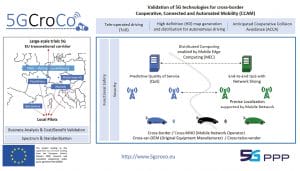5G PPP project 5GCroCo


Jesus Alonso-Zarate Apostolos Kousaridas
Centre Tecnològic de Telecomunicaions de Catalunya (CTTC) Huawei
jesus.alonso(at)cttc.es apostolos.kousaridas(at)huawei.com

Maciej Muehleisen
Ericsson GmbH
maciej.muehleisen(at)ericsson.com
The vision of cooperative, connected, and automated mobility (CCAM) in Europe can only be realized, when harmonized solutions that support cross-border traffic exist. The possibility of providing CCAM services across different countries for vehicles driving across various national borders has a huge innovative business potential. However, the seamless provisioning of connectivity and the uninterrupted delivery of real-time services across borders also pose technical challenges, which 5G technologies promise to solve. The situation is particularly challenging given that multiple road authorities, telecoms network operators, telecoms vendors, car manufacturers, and network generation scenarios are involved in any cross-border layout.
Motivated by this, the 5GCroCo project aims at validating 5G technologies in the Metz-Merzig-Luxembourg cross-border corridor, crossing the borders between France, Germany and Luxembourg. The 5GCroCo validation will focus on three use cases: 1. Tele-operated Driving (ToD), 2. High Definition (HD) map generation and distribution for automated vehicles (HD mapping), and 3. Anticipated Cooperative Collision Avoidance (ACCA). The results will help reduce the uncertainties associated with enhanced vehicle-to-everything (eV2X) communications across borders in Europe in preparation of commercial 5G deployment.
5G technologies in 5GCroCo
5GCroCo has identified a set of key 5G technologies which will become enablers for CCAM (see Figure 1). They have all been thoroughly evaluated in previous and ongoing research and innovation projects. Some of them are even commercially deployed already. The motivation of 5GCroCo is to evolve them to also fulfil their purpose and role in overall Quality of Service (QoS) fulfilment in cross-border, cross-MNO (Mobile Network Operator), cross-telco-vendor, and cross-automotive-OEM (Original Equipment Manufacturer) deployments. Service continuity is a particular goal in this context. The key technologies that have been identified are:
- Mobile Edge Computing/Cloud (MEC)
- Predictive QoS
- End to End (E2E) QoS with Network Slicing
- Precise positioning, and
- Cybersecurity
The V2X services that will be studied in the 5GCroCo trials for the selected use cases have unique characteristics which make the use of these technologies particularly interesting.
The first one is a limited area of interest. Information is often only needed close to the source where it was generated. This is true for many, but not all applications. It particularly applies to the use cases of HD mapping and ACCA. MEC-enabled cellular networks, but also direct communication omitting the cellular network, must therefore be part of the Vehicle-to-everything (V2X) architecture.
The second unique property is the multi-OEM-, multi-MNO- and multi-vendor challenge. For a typical mobile radio network, where main services run for voice and data communication, it does not matter that peering points between MNOs, vehicular clouds, and public data networks are located far from the “edge”. In a MEC-enabled V2X architecture, this problem must be solved, and the solution cannot be to have just one MEC provider. E2E QoS guarantees must be provided where needed, regardless of which MNO is serving the vehicle and also when roaming.
The third unique property is the role of the road authority as another source and sink of information. This comes along with often closed, sometimes even proprietary, information technology (IT) systems needing integration in an MEC-enabled V2X network architecture. A particular challenge arising from this is that crossing national, in some cases also regional borders results in a new road authority with its own IT infrastructure taking over responsibility.
With these technologies, 5GCroCo will address the gap of existing cellular V2X technologies, like, e.g., LTE Release 14, by enhancing a number of key performance indicators (KPIs) in the 5G network, such as latency, reliability, packet error rate, etc., even under the conditions of cross-border, cross-MNO, cross-telco-vendor, and cross-automotive-OEM operations.
Trial and test sites
5GCroCo will conduct large-scale trials in the European 5G Corridor passing by different cities of France, Germany, and Luxembourg. It is the so-called Metz-Merzig-Luxembourg Corridor and is part of the pan-European network of 5G corridors facilitated through several regional agreements. These agreements allow Europe to use hundreds of kilometers of motorways where tests can be conducted up to the stage where a car can drive autonomously with a driver present and always ready to regain control (third level of automation). These corridors are part of the European Commission’s 5G Action Plan, which aims at ensuring commercial deployment of 5G technologies by the end of this decade.
In addition to the large-scale trials in the corridor, 5GCroCo also plans to deploy local test pilots as a testing and integration step before large-scale deployment in the corridor. As shown in the figure, these tests will be deployed in Montlhéry-UTAC test-track (South of Paris, France), two in Germany (in the 5G-ConnectedMobility test-site, a section of Motorway A9 south of Nuremberg and a test-site in the Munich city center), one in the city of Barcelona (Spain) where a cross-border city setting will be emulated, and also in the AstaZero test-track (East of Gothenburg, Sweden). These tests will allow testing 5G functionalities locally (geographically close to the different involved partners), and possibly in restricted closed areas so that the complexity of doing the trials in the large-scale corridor can be managed. These tests will allow selecting and fine-tuning the 5G capabilities that will then be integrated in the large-scale trials, thus reducing the uncertainties associated to their deployment and trial.

5GCroCo solutions, trials and use cases
Key performance indicators
The approach in 5GCroCo will be to continuously monitor and evaluate the performance of the proposed 5G innovations in the trials based on the measurement of KPIs. First, KPIs related to telco operations will be considered. These include throughput, latency, packet error rate, reliability, session continuity or duration of potential interruption in case of cross-border-handover, maximum speed supported by user equipment, etc. In addition, there will also be KPIs associated to the specific use cases, from an application-oriented perspective, such as braking time, anticipation time, service interruption time, etc.
Business studies and spectrum
In addition to the 5G trials for CCAM, the study and definition of new business models and cost-benefit analysis is a fundamental part of 5GCroCo to understand the business possibilities that emerge from CCAM services which can operate across borders. The possibility of having advanced 5G functions operating in a cross-border, cross-MNO, cross-telco-vendor, and cross-automotive-OEM fashion generates a new arena for innovation. 5GCroCo will analyse the cost/benefit relationship of deploying 5G in such a complex scenario and develop tools which can allow for the definition of valid business models. This process will be done in parallel with the deployment of the trials, learning from the experience acquired, understanding the needs of all stakeholders, and reducing the uncertainties of deploying a 5G infrastructure to offer unprecedented 5G-enabled services for CCAM.
Finally, 5GCroCo also aims at evaluating the needs from the perspective of the usage of spectrum. A cross-border setting requires coordination among countries and operators to ensure that proper and efficient use and allocation of spectrum is conducted. 5GCroCo will also explore this area and plans to provide recommendations to relevant organizations.
About the project
5GCroCo is a 17-million-euro Innovation Action, partially funded by the European Commission under the Horizon 2020 programme, where key European partners from both telco and automotive industries have joined efforts to test and validate 5G technologies at a large scale in a cross-border setting. The mission is to reduce uncertainties, before CCAM services running on top of 5G communication infrastructures are offered on the market. 5GCroCo also aims at identifying business opportunities and defining new business models for disruptive CCAM services which can be possible thanks to 5G technology, as well as ensuring the appropriate impact into relevant standardization bodies both from the telco and automotive sectors. 5GCroCo is an important element of the 5G Infrastructure Association (IA) Trial Roadmap Strategy v2.02, being directly aligned with the 5G Action Plan for Europe and planning to contribute to and synchronize with the overall 5G Public Private Partnership (5G-PPP) ecosystem.
Further information
• 5GCroCo project website –
http://www.5gcroco.eu
• 5GCroCo Twitter account –
@5GCroCo